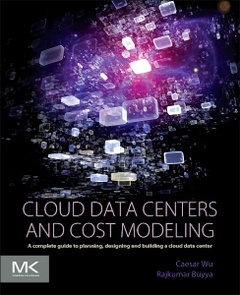Cloud Data Centers and Cost Modeling A Complete Guide To Planning, Designing and Building a Cloud Data Center
Auteurs : Wu Caesar, Buyya Rajkumar

Cloud Data Centers and Cost Modeling establishes a framework for strategic decision-makers to facilitate the development of cloud data centers. Just as building a house requires a clear understanding of the blueprints, architecture, and costs of the project; building a cloud-based data center requires similar knowledge. The authors take a theoretical and practical approach, starting with the key questions to help uncover needs and clarify project scope. They then demonstrate probability tools to test and support decisions, and provide processes that resolve key issues. After laying a foundation of cloud concepts and definitions, the book addresses data center creation, infrastructure development, cost modeling, and simulations in decision-making, each part building on the previous. In this way the authors bridge technology, management, and infrastructure as a service, in one complete guide to data centers that facilitates educated decision making.
Part I: Foundation1. Introduction2. Understanding Business Needs3. Common Challenges of Framing Business Problems
Part II: Data Centers4. Data Center Facility Planning, Site Selection and Space5. Power Management6. Cooling Strategies7. Physical Security
Part III: Infrastructure8. Servers9. Storage10. Network11. Virtualization12. Service Orchestration
Part IV: Cost Modeling13. Model Frameworks14. Leveraging Resources
Part V: Strategic Decision Making15. Monte Carlo Simulation16. Real Option Theory17. The Art of Critical Decision Making for Cloud Computing Investments18. Market-Oriented Cloud Computing
Dr. Rajkumar Buyya is Redmond Barry Distinguished Professor and Director of the Cloud Computing and
Distributed Systems (CLOUDS) Laboratory at the University of Melbourne, Australia. He is also serving as the
founding CEO of Manjrasoft, a spin-off company of the University, commercializing its innovations in Cloud
Computing. He has authored over 650 publications and seven textbooks including Mastering Cloud Computing
from McGraw Hill, China Machine Press, and Morgan Kaufmann for Indian, Chinese and international markets
respectively. Dr. Buyya is one of the most highly-cited authors in Computer Sience and Software Engineering
worldwide. “A Scientometric Analysis of Cloud Computing Literature by German scientists ranked Dr. Buyya
as the World's Top-Cited Author and the World's Most-Productive Author in Cloud Computing. He has been
recognized as a Web of Science “Highly Cited Researcher for four consecutive years since 2016. Dr. Buyya
was recognized as Scopus Researcher of the Year 2017 with Excellence in Innovative Research Award from
Elsevier; "Lifetime Achievement Awards" from two Indian universities, and the “Best of the World, in the
Computing Systems field, by The Australian 2019 Research Review. Software technologies for Grid, Cloud, and
Fog computing developed unde
- Explains how to balance cloud computing functionality with data center efficiency
- Covers key requirements for power management, cooling, server planning, virtualization, and storage management
- Describes advanced methods for modeling cloud computing cost including Real Option Theory and Monte Carlo Simulations
- Blends theoretical and practical discussions with insights for developers, consultants, and analysts considering data center development
Date de parution : 03-2015
Ouvrage de 848 p.
19x23.3 cm
Thèmes de Cloud Data Centers and Cost Modeling :
Mots-clés :
Aggregation; Airflow; Airside economizer; Alarm; Analytical Thinking; Architecture; Assumptions; Automatic transfer switch (ATS); BCube; Backward induction process; Basic tree; Battery monitoring; Benefits; Bidding instance; Binomial lattice; Blade server; Break-Fix Service Contract; Bridge; Brownian motion; Business Analysis; Business Requirements; Business Strategy; Business Value; Business knowledge; Business profile; Business solution; Business-based cost; CAN; CCTV; CPU; CPU cache; Cable layout; Cabling; Capacity Planning; Capex; Capital expenditure; Categories; Chasm; Chiller; Chip; Circuit breaker; Cloud Computing; Cloud service consumer; Cloud service providers; Cloud storage; Comfort cooling; Commodity switch fabric; Computational fluid dynamics (CFD) analysis; Computer room air condition (CRAC) unit; Computer room air handling (CRAH) unit; Containment; Cooling; Cooling strategy; Core; Core router; Cost framework; Cost model; Cost parameters; DAS; DRAM; Data Center; Data Center Architecture; Data center air distribution; Data center network topology; Data center power; Decision making; Dehumidifier; Diameter; Dimension; Direct variable cost; Disaster recovery (DR); Discount cash flow (DCF); Distributed Computing; Domain-based cost; Door-based cooling; Dragonfly; Ducted; E25K RISC Server; E2E cost framework; Economizers; Elastic Compute Cloud (EC2); Emerging technology; End of row (EoR); Extinguisher; FCIP; FCP; FCoE; Facility; Fan; Fat tree; Fee-based cost; Financial models; Fire classification; Fire detection; Fire suppression; Fire suppression solutions; Flammable objects; Flooded; Forward process; Free cooling



